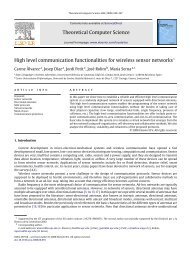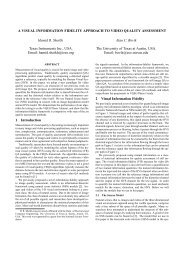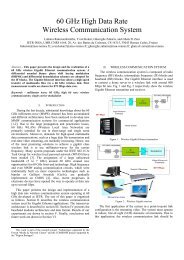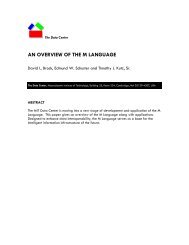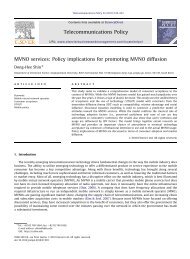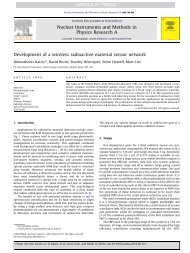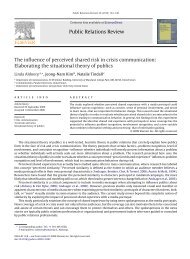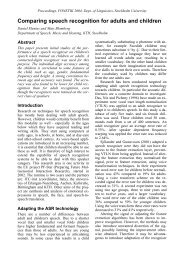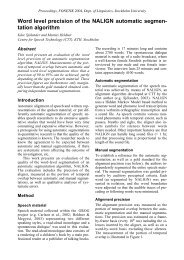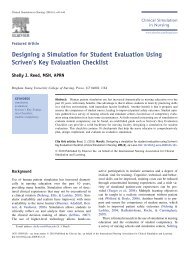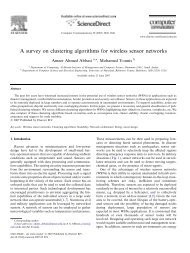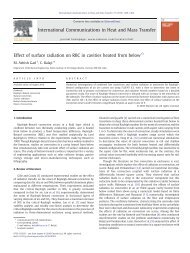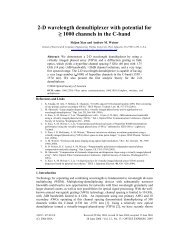Offline handwritten Arabic cursive text recognition using Hidden ...
Offline handwritten Arabic cursive text recognition using Hidden ...
Offline handwritten Arabic cursive text recognition using Hidden ...
You also want an ePaper? Increase the reach of your titles
YUMPU automatically turns print PDFs into web optimized ePapers that Google loves.
Table 4<br />
Top 1 <strong>recognition</strong> rate of ICDAR 2005 systems vs. our system<strong>using</strong> IFN/ENIT database v2.0p1e.<br />
System ID #1 #2 #3 #4 #5 #6 Our system<br />
No re-ranking With re-ranking<br />
Recognition rate 65.74 35.7 29.62 75.93 15.36 74.69 82.32 83.55<br />
Table 5<br />
Performance of <strong>recognition</strong> from various HMM-based systems <strong>using</strong> IFN/ENIT database v1.0p2.<br />
5.4. Error analysis<br />
Like all other systems, the proposed approach also has a certain<br />
level of error rate. Actually, our system with re-ranking has an error<br />
rate of 16.45% for tests <strong>using</strong> version v2.0p1e of the database,<br />
and this reduces to 10.76% if version v1.0p2 of the database is used.<br />
In fact, the main reasons for these errors can be summarized as<br />
follows.<br />
The first is inconsistency within the captured <strong>handwritten</strong> samples,<br />
which includes not only variations in shape and size, but also<br />
presence or absence of diacritical marks. As discussed in Section 2,<br />
diacritical marks are essential in distinguishing ambiguity between<br />
words, yet they can be skipped or put in various forms in <strong>handwritten</strong>.<br />
If one word contains samples in various writing styles/forms<br />
or different words share one similar shape, it inevitably leads to<br />
misclassification. Consequently, spelling check might be useful to<br />
solve this problem for improved accuracy (Khorsheed, 2003).<br />
The second is unbalanced occurrence of samples in the database,<br />
as this number varies from 3 to 381 (EL-HAJJ et al 2005).<br />
When one word has very limited samples, dividing them into different<br />
subsets affects its correct <strong>recognition</strong>, especially when the<br />
sample in test set appears differently from the one (or even absent)<br />
in the training sets. Taking the database of version v2.0p1e for<br />
example, Fig. 5 plots frequency vs. number of PAWs from both<br />
the training and test sets. As seen, there is apparent inconsistency<br />
between training and testing sets, which may lead to inaccurate<br />
modelling and low <strong>recognition</strong> rate. In addition, insufficient samples<br />
also lead to unreliable estimate of the re-ranking function,<br />
as both the mean and standard deviation for re-ranking cannot<br />
be accurately determined. Basically, more biased the samples are<br />
distributed in the test set against the whole database, more likely<br />
a higher error rate is generated. As shown in Table 6, the number of<br />
words for testing contained in test set (d) in database version<br />
v1.0p2 and test (e) in v2.0p1e are quite similar, i.e. 6735 vs.<br />
J.H AlKhateeb et al. / Pattern Recognition Letters 32 (2011) 1081–1088 1087<br />
Fig. 5. Difference of PAW frequency in training and test sets for ICDAR’05<br />
competition.<br />
Table 6<br />
Statistics of IFN/ENIT datasets in our tests.<br />
V1.0p2 V2.0p1e<br />
Whole set Test set (d) Whole set Test set (e)<br />
Number of words 26,459 6735 32,492 6033<br />
Number of writers 411 104 >1000 87<br />
6033. However, the degree of their biased distributions, as defined<br />
in (8), is different.<br />
g ¼ uw=ut; ð8Þ<br />
where g is the biased degree, u w and u t, respectively, refer to number<br />
of writers in the whole set and the test set. In our cases, the<br />
biased degrees for database versions v1.0p2 and v2.0p1e are determined<br />
as 3.95 and 11.49. Obviously, the distribution of test set in<br />
v2.0p1e is more biased. This further explains why tests <strong>using</strong> database<br />
of version v1.0p2 yield higher <strong>recognition</strong> rate than those<br />
<strong>using</strong> version v2.0p1e.



